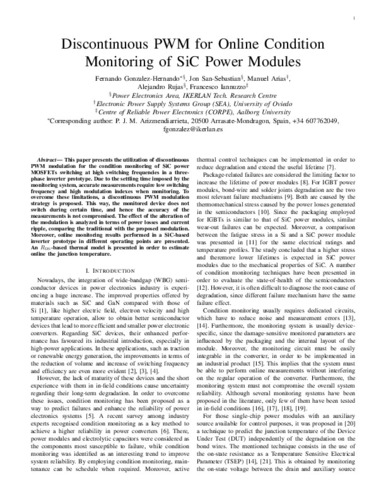Discontinuous PWM for Online Condition Monitoring of SiC Power Modules
Autor(es) y otros:
Palabra(s) clave:
Condition monitoring
Power MOSFET
Pulse width modulation inverters
Reliability
Silicon carbide (SiC)
Fecha de publicación:
Versión del editor:
Citación:
Descripción física:
Resumen:
This paper presents the utilization of discontinuous PWM modulation for the condition monitoring of SiC power MOSFETs switching at high switching frequencies in a threephase inverter prototype. Due to the settling time imposed by the monitoring system, accurate measurements require low switching frequency and high modulation indexes when monitoring. To overcome these limitations, a discontinuous PWM modulation strategy is proposed. This way, the monitored device does not switch during certain time, and hence the accuracy of the measurements is not compromised. The effect of the alteration of the modulation is analyzed in terms of power losses and current ripple, comparing the traditional with the proposed modulation. Moreover, online monitoring results performed in a SiC-based inverter prototype in different operating points are presented. An RDS-based thermal model is presented in order to estimate online the junction temperature.
This paper presents the utilization of discontinuous PWM modulation for the condition monitoring of SiC power MOSFETs switching at high switching frequencies in a threephase inverter prototype. Due to the settling time imposed by the monitoring system, accurate measurements require low switching frequency and high modulation indexes when monitoring. To overcome these limitations, a discontinuous PWM modulation strategy is proposed. This way, the monitored device does not switch during certain time, and hence the accuracy of the measurements is not compromised. The effect of the alteration of the modulation is analyzed in terms of power losses and current ripple, comparing the traditional with the proposed modulation. Moreover, online monitoring results performed in a SiC-based inverter prototype in different operating points are presented. An RDS-based thermal model is presented in order to estimate online the junction temperature.
Colecciones
Ficheros en el ítem




